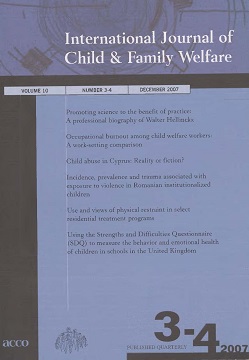Occupational burnout among child welfare workers: A work-setting comparison
Keywords:
burnout, occupational stress, child welfare, child and youth care, community, residential, social educationAbstract
Burnout in three groups of child welfare workers was studied: child and youth care workers in community settings (n = 139), residential workers (n = 190), and teachers (n = 51). The research hypotheses are: (1) the groups differ in their personal characteristics, perception of work environment, attitudes toward coping, and burnout; (2) different patterns of relationships exist between the main variables of the study for each group; (3) different patterns of contributors to burnout will appear in the community, residential, and teacher settings. Results supported the hypotheses showing significant differences between the three groups in the characteristics of the workers, work environment, levels of burnout and in the patterns of contributors to burnout, with community workers showing that an environmental climate related to empowerment was linked to a greater sense of accomplishment at work. Implications for educators, researchers, policy makers, and practitioners are discussed.

